site search
online catalog
“FORTY MILES A DAY ON BEANS AND HAY IN THE REGULAR ARMY-O” SCARCE INDIAN WAR US ARMY 1872 PATTERN SHOE FROM FORT PEMBINA, N.D.
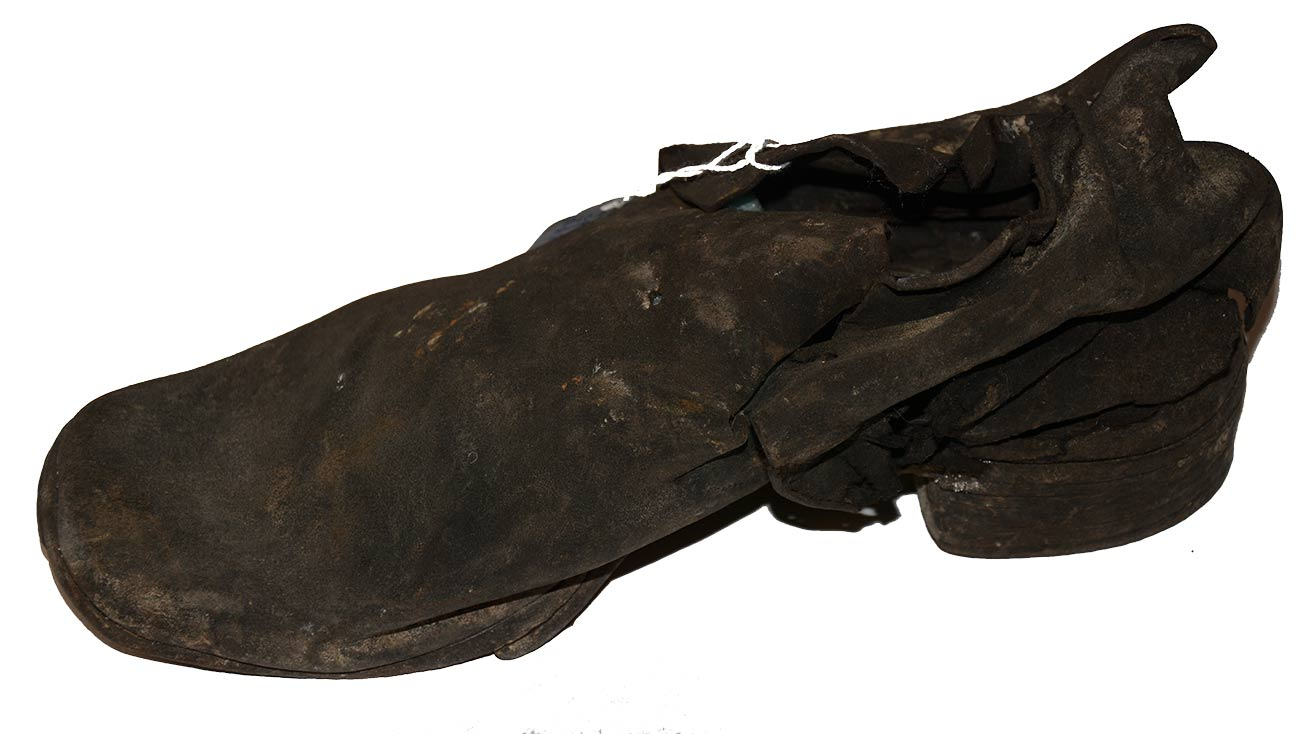
Hover to zoom

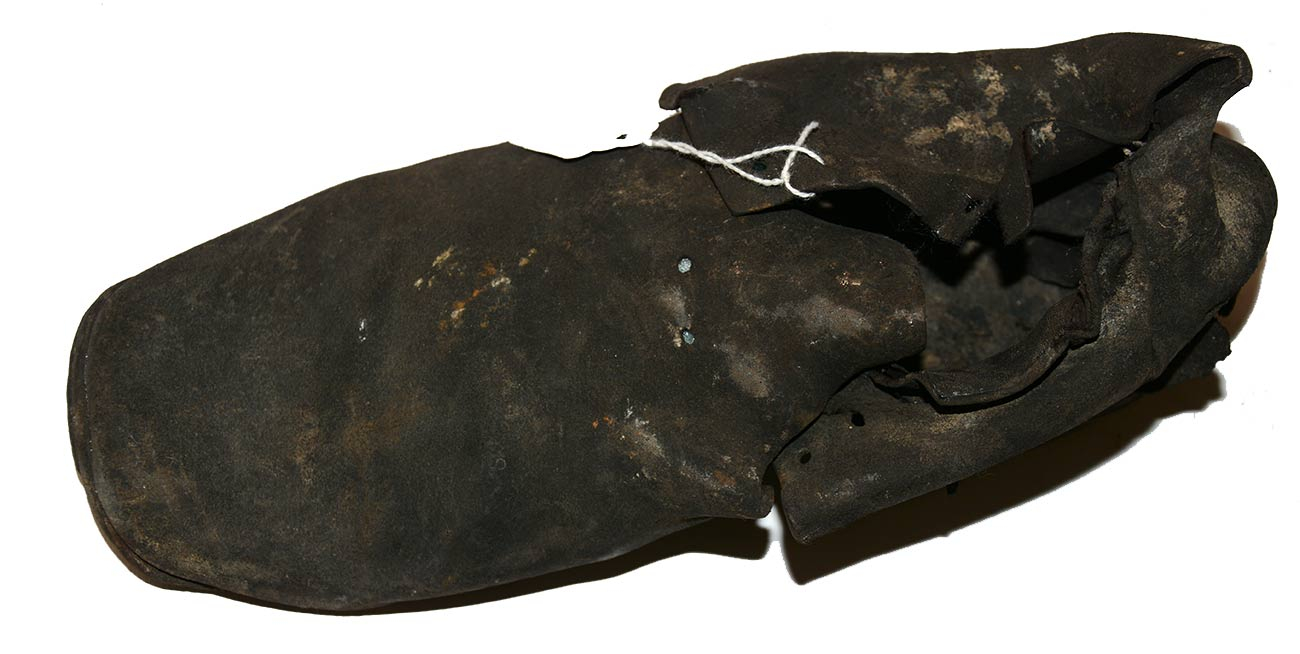
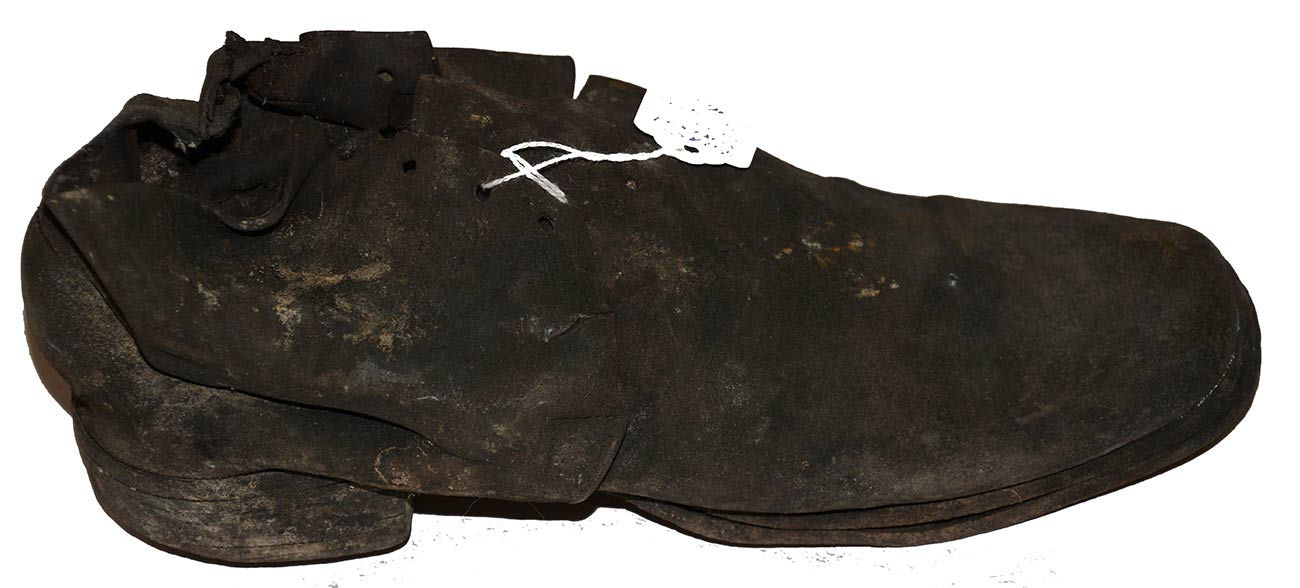
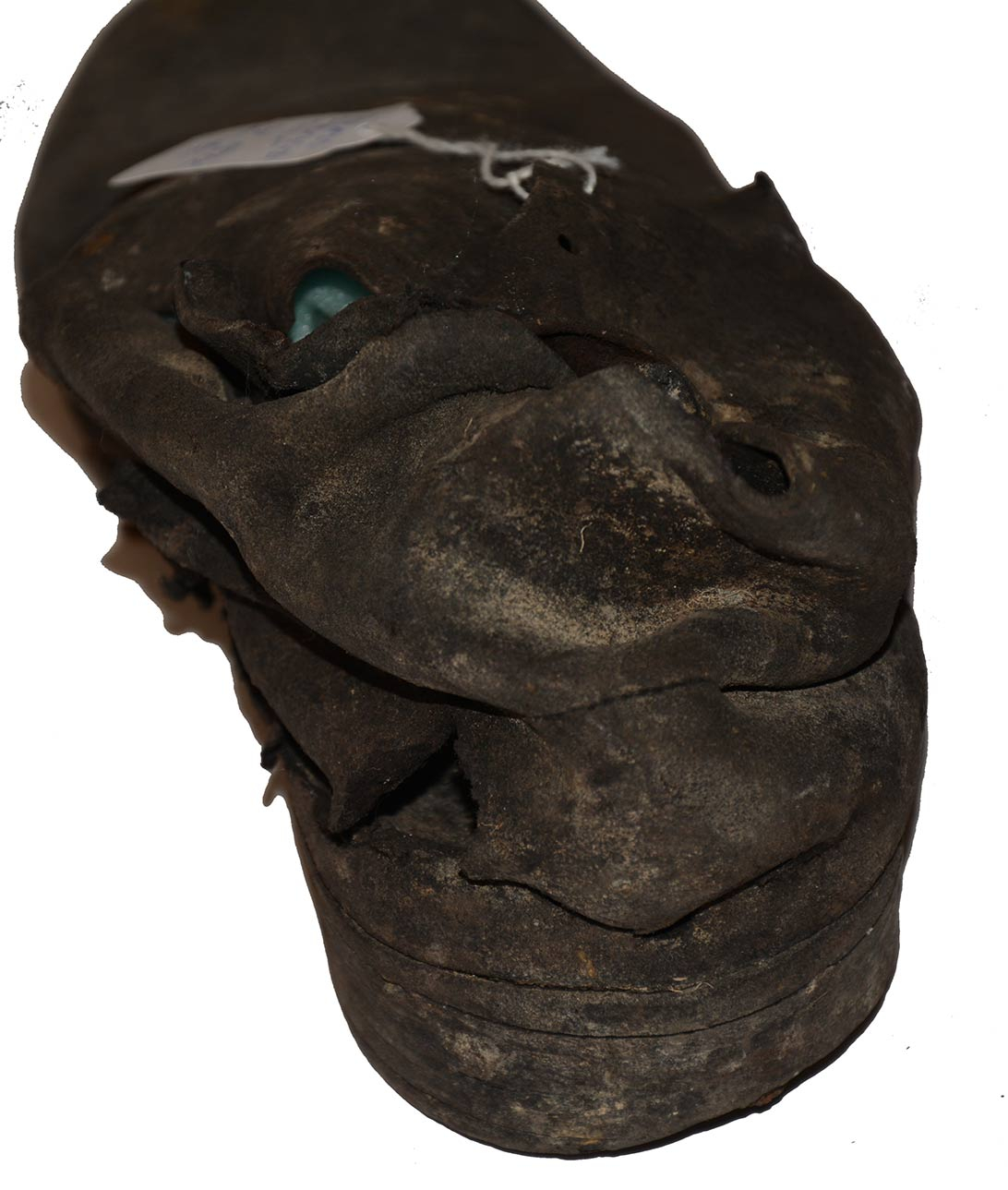
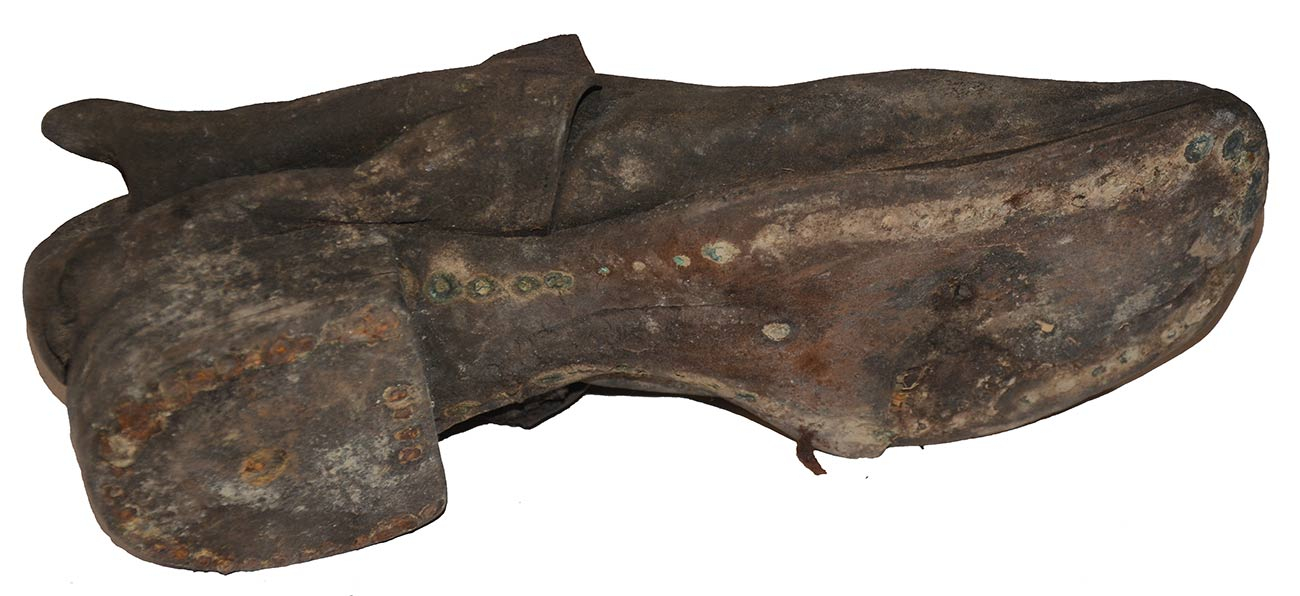
$495.00
Quantity Available: 1
Item Code: 1052-292
Shipping: Determined by Method & Location of buyer
To Order:
Call 717-334-0347,
Fax 717-334-5016, or E-mail
New pattern shoes and boots were introduced in the U.S. Army in 1872 and in use until the 1880s. These shoes were similar to Civil War issue patterns, with square toe, rough-side out black leather uppers consisting of vamp and quarters, an interior counter at the lower back, holes for shoelace or thong, in this case four on each side and two on the tongue, and with the uppers coming up a bit higher on the ankle than the Civil War versions. Their big improvement was in the use of brass screws to secure the soles rather than wood pegs or sewing. Those methods had proved insufficient on campaigns in the southwest where the arid climate dried the leather and the pegs came loose or the rough, rocky ground cut the stitching holding on the soles.
This one is solid. The leather is stiff and can be handled, and has oxidized slightly toward brown, showing some scattered white and gray stains. This is looks very much like a barn or attic-find from a veteran’s estate, but in fact was excavated at Fort Pembina, a US army fort established in 1870, where anaerobic soil conditions have yielded cloth and leather gear in remarkable states of preservation. (Think of the Roman fort at Vindolanda in Britain, where similar conditions are giving up 2,000 year-old sandals, etc.) The top of the ankle is bent and has folds. The vamp and quarters have separated along the stitching on lower sides, but are firmly in place from the rigidity of the leather. The heel, consisting of six pieces, is tight and in place, with the nails showing some corrosion, but no gaps in the leather pieces. The sole shows a piece missing on the left that exposes the inner sole, but is not very obvious, with the missing piece ½ to 1 inch wide and running back about 4 inches. The brass screws are all in place. This may not have been reason enough for the soldier discard it. The shoe also shows a long tear on the lower left of quarters from the instep to the back of the heel. It does not look like much of the leather itself is missing, but it did open up holes and would have made the shoe unwearable. We can only hope for the soldier’s sake that it was enough to draw a new pair without exceeding his clothing allowance, though getting a new pair at a remote post, may well have involved a wait.
Fort Pembina was situated in the Red River Valley in North Dakota near the Canadian border. Trading posts existed earlier in the area as part of the fur trade, and the first U.S. military post there was temporary- manned by a detachment of Minnesota troops in 1863-1864 following the 1862 Sioux uprising. In March 1870 a new fort was established south of the Pembina River and about 200 yards west of the Red River, completed by July and named in honor of Gen. George H. Thomas. The name was changed to Fort Pembina in September and the initial garrison consisted of two companies of the 20th US Infantry. Their main purpose was to provide security for settlers worried about Sioux returning south from Canada, but much of their duty involved escorting boundary surveys along the Canadian border and preventing Fenian raids heading north into Canada.
The fort included enlistedmen’s barracks, officers’ quarters, guard house, ordnance storehouse, company kitchen, root house, laundress’s quarters, quarters for civilian employees, hospital and hospital servant’s house, a barn for the “hospital cow,” quartermaster and commissary offices and storehouse, stables, wagon shed, etc. The garrison reached peak strength in 1878 of 200, but the average was about 125 enlisted men and 8 officers. An October 1885 return listed 97 men, 2 field pieces, 1 mountain howitzer, 100 rifles, 19 pistols, 23 mules, and 9 wagons. By 1890 the post had just 23 men, and after an 1895 fire destroyed some 19 buildings it was decided to abandon the fort rather than rebuild, the last detachment left in September. The property was turned over to the Interior Department and later sold in 1902.
This was excavated on private property with the owner’s consent and is a rough, but real relic of the western frontier army in the Indian Wars, as well a genuinely scarce piece of army-issue gear. Although an essential item, shoes were hardly the thing to be preserved by a soldier to remind him of hard marches or by his family in honor of his service, however arduous. [sr] [ph:L]
~~~~~~~~~~~~~~~~~~~~~~~~~~~~~~~~~~~
THIS ITEM, AS WITH ALL OTHER ITEMS AVAILABLE ON OUR WEB SITE,
MAY BE PURCHASED THROUGH OUR LAYAWAY PROGRAM.
CLICK HERE FOR OUR POLICIES AND TERMS.
THANK YOU!
Inquire About “FORTY MILES A DAY ON BEANS AND HAY IN THE REGULAR ARMY-O” SCARCE INDIAN WAR US ARMY 1872 PATTERN SHOE FROM FORT PEMBINA, N.D.
Most Popular
Historical Firearms Stolen From The National Civil War Museum In Harrisburg, Pa »
Theft From Gravesite Of Gen. John Reynolds »
Selection Of Unframed Prints By Don Troiani »
Fine Condition Brass Infantry Bugle Insignia »
Large English Bowie Knife With Sheath 1870’S – 1880’S »
Imported (Clauberg) Us Model 1860 Light Cavalry Officer's Saber »
featured item
INSCRIBED CIVIL WAR BOWIE OF ANDREW E. BENSON CO. D, 123rd NYV, TWO BUTTONS, G.A.R. VETERAN’S ID BADGE, CELLULOID PIN AND BOOK BY FELLOW VETERAN R.C. BULL
A nice grouping from a veteran of the 123rd New York, which served from September 1862 to June 1865, seeing action in the eastern and western theatres of war in the 12th/20th Army Corps. The group consists of his bowie knife, typical of those… (534-40). Learn More »


